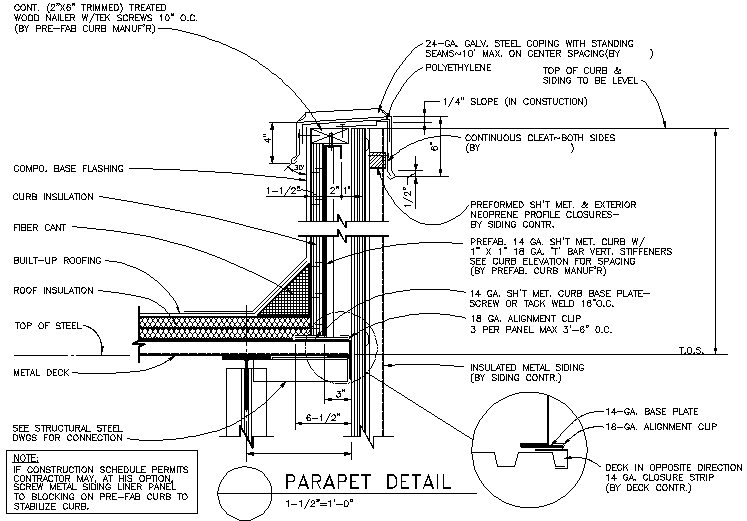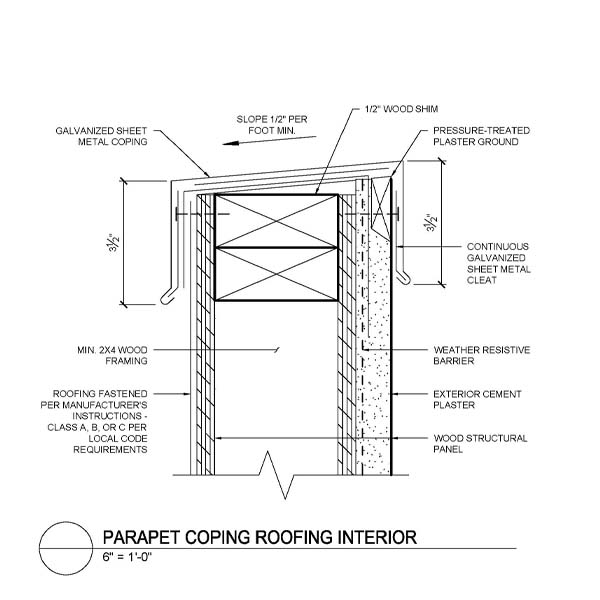
Detail Post Flat Roof Details First In Architecture
Parapet Wall Roofing Guide (Exterior Design Types + Construction Details) If you are looking for a quick parapet definition, skip ahead to the first section. Otherwise, choose the table of contents menu below for navigation to the parapet roof section you're most interested in. Table of Contents [ hide] What Is A Parapet? History of Parapets

MR8 Flat roof parapet detail, alternative coping
DESCRIBE the design of parapet components, including copings, cladding, sealants, mortar joints, in-wall flashings, and vapor barriers, and explain how each functions to protect wall and roof assemblies from water infiltration. DISCUSS the impact of code requirements for energy performance (e.g., the International Energy Conservation Code) on.

TYPICAL PARAPET DETAIL a photo on Flickriver
1. Height of roofing at wall: minimum of 12" to top of parapet. Do not lap TPO over top of parapet unless required by unique construction conditions. 2. Top of parapet, below cap, to be sealed with fluid applied flashing. 3. Venting in wood framed parapets: Provide venting to each wall cavity.

Commercial Building Plans by Raymond Alberga at
A parapet roof system consists of low walls, or similar structures, around the roofline of a flat roof. In pitched roofs, a parapet is formed where the top of the gable wall is extended above the height of the roof.. Conservation and refurbishment of roofs for heritage buildings demands attention to detail. They often use roof coverings made.

BrickVeneer Parapet Parapet, Flat roof design, Brick detail
of precise details can promote the longevity of a parapet and prevent common issues like freeze/ thaw deteriora-tion from arising. The goal is to di-minish the impact of moisture on the wall assem-bly by redirecting water away from the building. Copings. The first line of defense for a . parapet is the coping. Somewhat larger than the width of.

Typical parapet wall detail
Highly stylized, this roof design also adds beautiful detail to any home. Its compelling architectural detail can put an intriguing finishing touch on structures. Very versatile, parapet roof designs can be used with all sorts of roof designs. For instance, you can have a gable and parapet roof in the same design. Things to Consider

Moisture Management of Parapet Walls Masonry Technology, Inc.
This detail is intended to be used where wall heights are greater than 24 inches above roof surface. The profile of specific components, their configuration or sequencing, can vary with the roof system, climatic differences, and regional or area practices. Dimensions as shown are recommended minimums and are intended to be approximate to allow for reasonable tolerances due to field conditions.

Parapet Roof Plan New Home Plans Design
A parapet roof is essentially an extension of a wall that extends beyond the roofline. It can be found on a variety of building types, from commercial to residential. One of the primary benefits of a parapet roof is that it can help to improve the safety of a building. By extending the wall above the roofline, it can provide a barrier that.

Basic Steel Framing Details for MidRise Construction Light Steel
A parapet roof is, simply put, when a building's outermost walls extend upwards past the roof around the edges, most often by a few feet. While a roof parapet wall may seem like a small detail in the grand scheme of the entire building design, it can actually change the dynamic of an entire roof, both in terms of cosmetic detailing and safety.

Parapet Detail Section sandyohlsonfloraldesign
These transition points, where the flat part of the roofing system is tied into the parapet wall, are potentially vulnerable areas for water intrusion. Following the requirements for proper flashing can help ensure that the roof system offers better protection. How do you install flashing on the wall and roof?

Parapet Coping Stucco Exterior, Roofing Interior WoodWorks Wood
Characterized as a low wall, the parapet projects above the roof plane and typically spans around the perimeter of the roof area. Histori-cally, parapets were constructed of masonry, consisting of multi-wythe walls with mortar-fi lled collar joints, capped with a coping.

Parapet Wall Detail Sketch Parapet, Roof detail, Roof extension
Some of the more common ways I have seen the ends of copings detailed include the following: 1) the coping terminates horizontally at or near the surface of the wall cladding; 2) the coping extends into the wall cladding (for example, masonry or EIFS) without an upturned leg and integral side flanges; and 3) the coping terminates within the wall.

12 best Parapet Detail images on Pinterest Architecture details
It can add decorative detail to a home. A parapet can make a gable roof appear to be a flat roof, ideal for modern-style architecture. If you have a flat roof, a parapet can work as a railing, making your rooftop space safer or giving you a space to conceal outdoor equipment. A well-constructed parapet can help shield a roof from wind damage.

Pin on Roof
BUILDING SCIENCE Parapets Part 3: An Example of Complexity By Benjamin Meyer 03-23-2020 Part 1 of our discussion of parapets ( Continuity of Control Layers) explored the many reasons continuity of water, air, thermal, and vapor control layers are necessary for long term performance.

Image result for Parapet Screed Parapet, Cladding, Building design
Parapet roof designs were originally created for temples, castles, and towers as defensive structures. By technical definition, a parapet roof is an extension of a wall that's at the edge of a roof, balcony, terrace, walkway, or structure. It's a short, vertical wall that runs the roofline of any building. And though the style has changed.

Green roof parapet detail Roof architecture, Green roof, Parapet
Parapets dramatically reduce these pressure differences at roof edges ( Figure 3 ). Neat eh? All this from a University of Toronto guy, go Varsity Blues (Leutheusser, H.J., 1964 ( 2) ). Figure 1: Roof Edge Wind Effects —When wind blows against a building, it produces vortices at the roof edges.